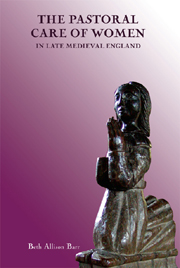Book contents
- Frontmatter
- Contents
- Miscellaneous Frontmatter
- Acknowledgments
- List of Abbreviations
- Introduction: “Be it husband, be it wife”
- 1 Pastoral Vernacular Literature
- 2 Pastoral Language
- 3 Pastoral Perceptions
- 4 Pastoral Care
- Conclusion: Gendered Lessons
- Appendix I The Manuscripts of Mirk's Festial
- Appendix II The Exampla of Mirk's Festial
- Bibliography
- Index
3 - Pastoral Perceptions
Published online by Cambridge University Press: 12 September 2012
- Frontmatter
- Contents
- Miscellaneous Frontmatter
- Acknowledgments
- List of Abbreviations
- Introduction: “Be it husband, be it wife”
- 1 Pastoral Vernacular Literature
- 2 Pastoral Language
- 3 Pastoral Perceptions
- 4 Pastoral Care
- Conclusion: Gendered Lessons
- Appendix I The Manuscripts of Mirk's Festial
- Appendix II The Exampla of Mirk's Festial
- Bibliography
- Index
Summary
FROM THE generous acknowledgment of women within some manuscripts to the regular inclusion of women within pastoral discussions of most manuscripts, clerical writers of vernacular sermon compilations recognized female parishioners as an ordinary part of pastoral care – both informing priests how to care for women and informing women how to fulfill their spiritual obligations. But who were the female parishioners to whom clerical writers acknowledged pastoral debt? Omnis utrusque sexus, the decree of Fourth Lateran Council, did not imply discrimination against any within the Church's care, male or female. It demanded blanket observance. In practice, however, when clerics penned their sermon compilations and instruction manuals, what types of women did they envision as typical petitioners? Their compassion would have extended to comely maidens, pious matrons, and chaste widows. But how much further would it have gone? Would it have extended to older singlewomen, working women, and those of ill-repute? Or would some women have slipped through the cracks? In short, did clerical writers approach female parishioners as they actually were or only as they were imagined?
A poignant exemplum from Festial sheds light on this matter. A bishop ready to administer the sacrament on Easter Sunday prayed that God would reveal to him the parishioners worthy and unworthy to receive the Host. As the people streamed in the church doors, making their way toward the sacrament table, the bishop realized that his prayer had been granted.
- Type
- Chapter
- Information
- The Pastoral Care of Women in Late Medieval England , pp. 62 - 93Publisher: Boydell & BrewerPrint publication year: 2008

